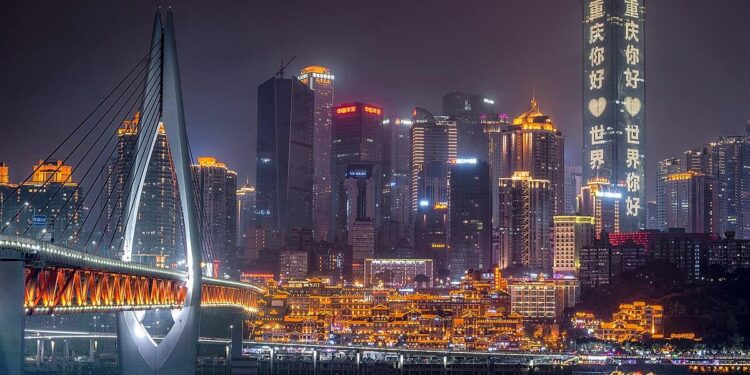Chongqing: The World’s Most Complex Vertical City Explained
In an era where urbanization continues to reshape landscapes, the sprawling city of Chongqing stands as a testament to human ingenuity and architectural ambition. Nestled at the confluence of the Yangtze and Jialing rivers in southwestern China, Chongqing has evolved into the world’s most complex vertical city, characterized by its intricate layering of skyscrapers, transport systems, and residential areas. As the city grapples with challenges posed by its unique topography and rapid population growth, it has developed innovative solutions that blend functionality with striking aesthetics. In this article, we delve into the architectural marvels and urban planning strategies that define Chongqing, exploring how this dynamic metropolis not only meets the needs of its inhabitants but also redefines our understanding of urban living in the 21st century. Join us as we unpack the complexity and beauty of a city that reaches for the skies while intricately weaving together the fabric of daily life.
Exploring Chongqing’s Unique Urban Design: A Deep Dive into Vertical Architecture
Chongqing stands as a testament to the ingenuity of modern urban planning, characterized by its terraced landscapes and a network of vertical architecture. With buildings soaring high and interconnected through an intricate web of glass bridges, the city redefines conventional urbanism. The unique topography accentuates these designs, necessitating innovative solutions that blend functionality with aesthetics. As you navigate Chongqing, you will encounter a multitude of buildings that serve multiple purposes, housing residential spaces, retail outlets, and recreational areas all within the same vertical footprint. This approach not only maximizes space but also fosters a vibrant urban community.
The city’s commitment to sustainability is exemplified through several of its signature projects, where green roofs and vertical gardens are seamlessly integrated into the design. Key features of Chongqing’s vertical cityscape include:
- Multi-level transportation systems: Connecting various districts with ease.
- Adaptive reuse of structures: Transforming old buildings into modern spaces.
- Parks and public spaces: Offering green retreats amidst urban density.
Furthermore, in projects like the Raffles City Chongqing, ambitious designs featuring cantilevered sections challenge traditional architectural limits, inviting both local residents and tourists to reflect on the interplay between nature and urban life. By embracing its vertical nature, Chongqing not only maximizes land use but also paves the way for a sustainable and dynamic future.
Navigating the Challenges of Life in a Multi-Layered City: Infrastructure and Transportation Insights
Chongqing’s unique geography poses significant challenges for urban planners and residents alike. The city is known for its steep hills and twisting rivers, creating a complex tapestry of urban development that often requires innovative solutions. Public transportation systems have evolved rapidly to accommodate this vertical landscape, featuring a mix of modes including:
- Subway Lines: Deep underground lines that connect various city levels and reduce street congestion.
- Elevated Walkways: These structures are vital for pedestrian movement, offering safe passage across busy streets.
- Cable Cars: Scenic routes that not only provide transportation but also stunning views of the city.
Moreover, the intricate infrastructure emphasizes the importance of efficient roadways to manage traffic flow. Recent statistics show the growth in transportation efficiency:
| Year | Transportation Routes (km) | Daily Passengers (millions) |
|---|---|---|
| 2018 | 1,200 | 3.5 |
| 2020 | 1,500 | 4.2 |
| 2022 | 1,800 | 5.0 |
As the city’s population continues to grow, integrating advanced technology in public transit, such as smart traffic management systems, has become imperative. By focusing on sustainability and creating a seamless travel experience, Chongqing is not just adapting to its complex nature but is also setting a precedent for future multi-layered cities worldwide.
Sustainable Development in Chongqing: Innovations and Recommendations for Future Growth
Chongqing has emerged as a model for urban development strategies that effectively balance growth with environmental stewardship. The city’s remarkable vertical infrastructure not only maximizes land use but also minimizes the carbon footprint through advanced technologies. Key innovations in Chongqing’s approach include:
- Integrated Public Transport Systems: Emphasizing seamless connectivity among various modes of transport reduces reliance on personal vehicles.
- Green Building Initiatives: Adoption of sustainable materials and energy-efficient designs is reshaping the skyline while cutting energy costs.
- Vertical Green Spaces: Rooftop gardens and wall vegetation are implemented to improve air quality and biodiversity in urban settings.
Moving forward, adopting further sustainable practices will be crucial for Chongqing’s future growth. Strategic recommendations include:
- Enhanced Policy Frameworks: Developing clear regulations that incentivize sustainable practices in construction and urban planning.
- Community Engagement Programs: Involving local residents in sustainability initiatives to foster a culture of environmental responsibility.
- Technological Collaboration: Partnering with tech firms to utilize smart city technologies for real-time resource management and urban logistics.
Insights and Conclusions
As we conclude our exploration of Chongqing, the world’s most complex vertical city, it becomes evident that this urban masterpiece is a testament to innovative architecture and engineering. The city’s unique topography and dense population have compelled designers and planners to think beyond traditional boundaries, resulting in a breathtaking skyline characterized by layered structures and interconnected spaces. Chongqing not only serves as a model for modern urban development but also challenges conventional notions of city living. As we continue to examine the evolving landscapes of major global cities, Chongqing stands out as a vivid reminder of the potential for creativity and resilience in urban design. For more insights into the intersections of architecture and society, stay tuned to parametric-architecture.com.














Italy to Deport Egyptian Imam After Controversial Comments at Pro-Palestine Rally